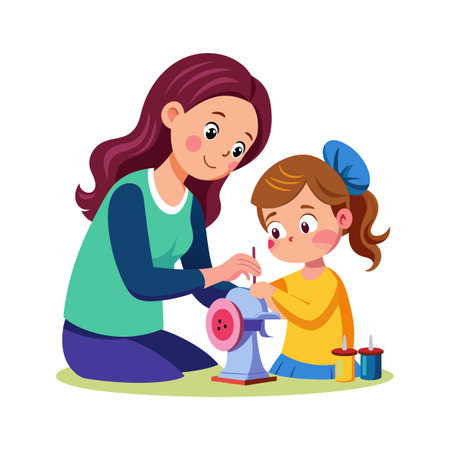1. Understanding the Right Time to Start
Potty training is a big milestone for both parents and toddlers, but knowing when to start can make all the difference. Every child develops at their own pace, so recognizing the signs that your little one is ready is key to a smooth and successful transition.
Signs Your Child May Be Ready
Before you begin potty training, look for these common readiness signs:
| Signs of Readiness | Description |
|---|---|
| Stays dry for longer periods | Your child can keep their diaper dry for at least two hours or wakes up from naps with a dry diaper. |
| Shows interest in the potty | Your toddler watches others use the bathroom, asks questions about it, or wants to sit on the potty. |
| Able to communicate needs | Your child can tell you when they need to go or recognize when they’ve already gone. |
| Pulls down pants independently | Your little one has the motor skills to pull down and pull up their pants without help. |
| Dislikes dirty diapers | Your child may show discomfort when wearing a wet or soiled diaper and ask for a change. |
| Keeps a regular schedule | You notice that your toddler tends to go at predictable times each day. |
The Ideal Age Range for Potty Training
The best time to start potty training varies from child to child, but most kids are ready between 18 months and 3 years old. Here’s a general guideline:
| Age Range | What to Expect |
|---|---|
| 12-18 months | A few children may show early interest, but most aren’t physically ready yet. |
| 18-24 months | This is when some toddlers begin showing signs of readiness, though many still need more time. |
| 24-36 months | The majority of children are developmentally prepared for potty training in this range. |
| 3+ years old | If your child hasn’t started yet, don’t worry! Some kids take longer and that’s perfectly normal. |
The Importance of Timing and Patience
If you start too early, your child may resist or struggle with accidents. On the other hand, waiting until they’re truly ready can make the process much easier. Avoid beginning during stressful times like moving to a new house, welcoming a new sibling, or starting daycare.
A Quick Readiness Checklist:
- Your child shows multiple signs of readiness (not just one).
- You have time and patience to support them through the process.
- Your toddler is interested and willing to try.
- No major life changes are happening that could cause stress.
If your child isn’t quite ready yet, don’t rush it! Give them more time and try again in a few weeks or months. Potty training should be a positive experience for both of you!
2. Essential Potty Training Supplies
Having the right supplies can make potty training much easier for both you and your child. Here are the must-have items that will help create a smooth and successful experience.
Potty Chairs and Seats
A potty chair or seat is one of the most important tools for potty training. Choose an option that makes your child feel comfortable and secure.
| Type | Description |
|---|---|
| Standalone Potty Chair | A small, toddler-sized potty that sits on the floor. Great for independence and easy to move around. |
| Potty Seat Reducer | A seat that fits onto a regular toilet, making it smaller for little ones. Ideal for transitioning to the big toilet. |
| 2-in-1 Potty Chair | A potty chair that can be used as a standalone unit or placed on top of a regular toilet. |
Training Pants and Underwear
Your child will need training pants or underwear designed for potty training. These help them feel when they are wet while still providing some protection against accidents.
- Pull-up Training Pants: A great in-between option between diapers and underwear. They allow kids to pull them up and down easily.
- Cotton Training Underwear: Thicker than regular underwear, helping to absorb small accidents while encouraging awareness of wetness.
- Regular Underwear: Once your child is more confident, switching to regular underwear can reinforce their progress.
Cleaning Essentials
Pee and poop accidents are inevitable during potty training, so its best to have cleaning supplies ready to handle any messes quickly.
- Flushable Wipes: Softer than toilet paper and great for little hands learning to wipe properly.
- A Good Disinfectant Spray: Helps keep the potty clean and eliminates germs after accidents.
- Pee Pads or Waterproof Mats: Useful for protecting furniture, car seats, or beds during the transition period.
- A Travel Potty: Perfect for trips out of the house when bathrooms arent easily accessible.
Praise and Reward System
Praise goes a long way in motivating your child during potty training. Consider using small rewards or incentives to encourage success.
- Sticker Chart: A fun way to track progress by adding stickers every time they successfully use the potty.
- Treats or Small Prizes: Some parents use small toys or special treats as motivation.
- Lots of Verbal Encouragement: Simple phrases like “Great job!” or “Im so proud of you!” can boost their confidence.
The Right Attitude
The most important thing you can bring to potty training is patience! Every child learns at their own pace, so staying positive and encouraging will help make the process smoother for both of you.

3. Effective Potty Training Methods
Every child is different, so there’s no one-size-fits-all approach to potty training. Some kids respond well to fast-paced methods, while others need a slower transition. Let’s explore some of the most popular potty training techniques and help you find what works best for your little one.
The 3-Day Method
This is a fast-track approach that requires commitment and consistency. Over three days, your child will go diaper-free and use the potty exclusively.
How It Works:
- Choose a long weekend or time when you can stay home.
- Let your child wear underwear only—no diapers or pull-ups.
- Encourage frequent potty trips and celebrate successes.
- Expect accidents and handle them calmly.
Best For:
Toddlers who show readiness signs and thrive with routine-based learning.
Gradual Potty Training
This method takes a slower, more relaxed approach, letting your child ease into potty use over weeks or months.
How It Works:
- Start by introducing the potty and letting your child sit on it fully clothed.
- Encourage potty time after meals or before naps.
- Praise every small success without pressure.
- Transition from diapers to pull-ups, then to underwear when ready.
Best For:
Kiddos who need time to adjust or parents who prefer a low-stress approach.
The Reward System
This approach uses positive reinforcement to encourage potty use.
How It Works:
- Create a reward chart with stickers or small prizes.
- Praise every attempt, even if they don’t go right away.
- Avoid punishment for accidents—keep it fun!
Best For:
Children motivated by rewards and encouragement.
Comparison of Potty Training Methods
| Method | Description | Best For |
|---|---|---|
| The 3-Day Method | An intensive, fast-paced approach requiring full commitment. | Toddlers ready for quick learning and structured routines. |
| Gradual Potty Training | A slow transition allowing kids to adapt at their own pace. | Kiddos who need more time or parents preferring flexibility. |
| The Reward System | A motivation-based approach using praise and small incentives. | Children who respond well to encouragement and rewards. |
No matter which method you choose, patience and consistency are key. Every child learns differently, so be prepared to adjust as needed. Stay positive, celebrate progress, and make the experience as stress-free as possible!
4. Handling Setbacks and Accidents
Potty training isn’t always a smooth journey, and setbacks are completely normal. Accidents will happen, and it’s important to approach them with patience and positivity. Here’s how you can effectively handle setbacks and keep your child motivated.
Stay Calm and Positive
Reacting with frustration or disappointment can make your child feel ashamed or anxious about potty training. Instead, use a calm and reassuring tone when accidents occur. Let them know that mistakes are part of learning and that they’re doing a great job trying.
Encourage Your Child Without Pressure
Avoid forcing your child to use the potty if they resist. Pressuring them can create negative associations with toilet training. Instead, offer gentle encouragement, praise their progress, and celebrate small victories.
Use Encouraging Words
Your words matter! Instead of saying, “Why did you have an accident?” try phrases like:
- “That’s okay! Next time, let’s try to get to the potty sooner.”
- “You’re learning, and I’m so proud of you!”
- “Oops! Let’s clean up together and try again next time.”
Create a Cleanup Routine
If an accident happens, involve your child in the cleanup process in a positive way. This helps them understand responsibility without making them feel bad about their mistake.
Recognizing Common Causes of Setbacks
If your child suddenly starts having more accidents, there could be an underlying reason. Here are some common causes and how to address them:
| Possible Cause | How to Handle It |
|---|---|
| Anxiety or stress (new sibling, moving, changes in routine) | Provide reassurance, maintain a consistent schedule, and give extra comfort. |
| Your child is too distracted while playing | Set regular potty reminders to help them take breaks. |
| Your child is not fully ready yet | If resistance is high, take a short break from training and try again later. |
| Mild illness or constipation | Ensure they stay hydrated and have enough fiber in their diet. |
Praise Progress, Not Perfection
Praise your child for trying rather than just for success. Even if they don’t make it to the potty in time, acknowledge their effort: “You tried so hard! Let’s keep practicing.” Small rewards like stickers or extra storytime can also boost motivation.
Avoid Punishment or Shame
Punishing or shaming your child for accidents can slow down progress and cause anxiety around potty training. Keep the experience positive by focusing on what they did right instead of what went wrong.
Keep Extra Clothes Handy
Dressing your child in easy-to-remove clothing can help prevent last-minute accidents. Keep spare clothes nearby at home and when going out to avoid stress during mishaps.
The Key: Patience and Consistency
The most important thing is to stay patient. Every child learns at their own pace, and setbacks are just part of the journey. With consistency, encouragement, and a positive attitude, your little one will gain confidence and succeed!
5. Nighttime Potty Training Strategies
Nighttime potty training is a different challenge compared to daytime training. While your child may have mastered using the potty during the day, staying dry overnight takes time and patience. Understanding these differences can help you set realistic expectations and support your child through this process.
Understanding Daytime vs. Nighttime Training
Daytime potty training typically happens faster because your child is awake, aware of their body signals, and can easily get to the bathroom. Nighttime training, on the other hand, depends on physical development, such as bladder capacity and the ability to wake up when needing to go.
| Daytime Potty Training | Nighttime Potty Training |
|---|---|
| Easier to recognize when they need to go | Harder because they are asleep |
| Can quickly reach the potty | Might not wake up in time |
| Takes days or weeks to master | May take months or longer |
How to Help Your Child Stay Dry at Night
Create a Bedtime Bathroom Routine
Encourage your child to use the potty right before bed. This helps empty their bladder and reduces the chance of accidents overnight.
Limit Fluids Before Bedtime
Avoid giving large amounts of fluids in the evening, especially an hour before bedtime. This can help reduce nighttime accidents.
Use Protective Bedding
A waterproof mattress protector can make cleanup easier if accidents happen. You can also layer sheets with a protector in between for quick changes at night.
Praise Progress, Not Perfection
Your child will have some dry nights and some accidents—this is completely normal. Encourage them by celebrating progress instead of focusing on setbacks.
Consider Using a Nightlight and Easy Access to the Bathroom
If your child wakes up needing to go, a nightlight can make it easier for them to find their way to the bathroom. You can also keep a small potty nearby if the bathroom is too far.
Be Patient and Let Nature Take Its Course
The ability to stay dry at night often depends on physical development. Some children naturally outgrow bedwetting later than others. If your child continues having frequent accidents past age six or seven, consult a pediatrician for guidance.
6. Encouragement and Positive Reinforcement
Potty training is a big milestone for your child, and creating a positive experience can make all the difference. Encouragement and positive reinforcement help build confidence, reduce stress, and motivate your little one to keep trying. Lets explore how praise, rewards, and consistency can support this journey.
The Power of Praise
Children thrive on positive feedback. A simple “Great job!” or “Im so proud of you!” can boost their confidence and make them excited about potty training. Be specific with your praise—acknowledge their effort by saying things like:
- “You sat on the potty like a big kid!”
- “You told me you needed to go—awesome job!”
- “You kept your underwear dry all morning—fantastic!”
Using Rewards Effectively
Small rewards can be a great way to encourage consistency. Consider using a reward system that matches your childs interests. Here are some ideas:
| Reward Type | Examples |
|---|---|
| Stickers & Charts | A sticker for every successful trip to the potty; a small prize after earning five stickers. |
| Treats & Small Prizes | A special snack, an extra bedtime story, or a small toy for staying dry all day. |
| Praise & High-Fives | A big hug, high-five, or happy dance to celebrate their success. |
| Special Activities | A trip to the park, extra playtime, or picking out new underwear as a fun reward. |
The Importance of Consistency
Consistency is key when it comes to potty training. Set clear expectations and stick to them so your child knows what to expect. Here’s how you can maintain consistency:
- Create a routine—take your child to the potty at regular intervals.
- Use the same words and phrases each time (“Time to go potty!”).
- Avoid punishments—stay patient even when accidents happen.
- Celebrate progress, no matter how small!
What If Your Child Loses Interest?
If your child starts to resist potty training, dont panic! Take a step back and assess if they need a short break. Keep encouraging them with gentle reminders and avoid pressure. Sometimes, taking the stress out of the process helps them regain interest naturally.


